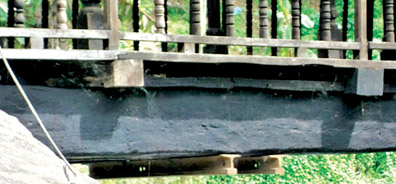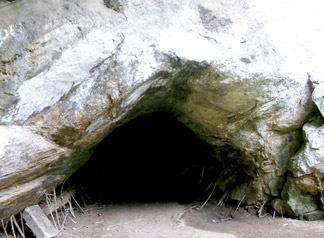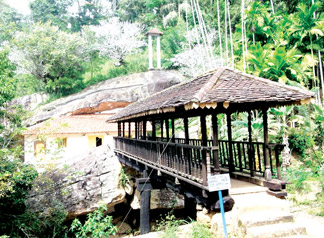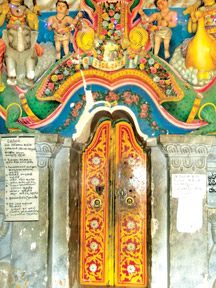Bogoda Bridge a marvel of history
by Manjula Fernando
 We were on a three day pleasure trip to Badulla and Nuwara Eliya in a
hired Toyota Dolphin. Half way into our journey there was a call from my
uncle, a forest officer with over 30 years working experience all over
the country. We were on a three day pleasure trip to Badulla and Nuwara Eliya in a
hired Toyota Dolphin. Half way into our journey there was a call from my
uncle, a forest officer with over 30 years working experience all over
the country.
“You should never miss the ancient wooden bridge in Badulla. It is
amazing and the kids must see it, “ was his advice.
My two office colleagues and our families had better things in mind.
We had to make this trip enjoyable as much as possible. It was our way
of rejuvenating and getting ready for another hectic year ahead. With
young schooling kids and a demanding office front, all three of us and
the spouses were looking for a means to let out the steam. The last
thing on mind was another educational outing.
Muthiyangana temple

The cave where King Walagamba found refuge during his days of
hiding |

The 'awasa ge' built by King Sri Wickrema Rajasinghe |

The entrance to the 22km long secret tunnel |
 |
| The historic
Bogoda bridge and the 2000 year old Temple across the river. The
bridge needs urgent restoration |
However, what we heard at the historic Muthiyangana temple, from one
of the bhikkhus – Iskole Hamuduruvo - roused our curiosity and we
decided to pay a visit to the Sacred Bogoda temple and the wooden
bridge.
After tying ‘pirith nool’ on each one of us the bhikkhu invited the
whole group to sit down on the floor. Beginning with a brief history of
Muthiyangana Rajamaha Vihara, Iskole Hamuduruvo spoke of the Bogoda
Temple and the famous bridge, which is renowned as the oldest surviving
wooden bridge in the world.
The place, we were told, was situated 10 km from Hali Ela.
“The Nayaka Hamuduruwo is a friend of mine, so do let me know if you
go there,” he offered.
But it was not till the day of return, we had the chance of visiting
this historic place surrounded by mythical stories of King Walagamba
finding refuge in the cave temple and the adjoining tunnel during his
days of hiding and the secret mission of recapturing the throne.
Dunhinda Falls
The first two days we were struggling down the impossible trek to
breathtaking Dunhinda Falls, and cycling and horse-riding in Nuwara
Eliya by the Gregory's Lake which had seen an amazing transformation due
to development work by the UDA.
The road to Bogoda bridge was not an easy one. From Badulla to Hali
Ela was a smooth journey, as well as the nearly eight kilometre stretch
to Jagulla junction. The next three kilometres to the temple proved
impossible. Part of the road was under construction.
Nevertheless, all as one were determined to make it to the temple. We
decided to park the vehicle near Jagulla junction much to the relief of
the driver.
All of us packed into two trishaws and began to tread the difficult
path which had been laid with metal stones in preparation to spray road
tar. Half way, a worker warned the work is about to begin and there will
be a long wait to go back. Crestfallen, we all got down from the
vehicles. Just then an elderly bi-spectacled person came to our rescue.
He reassured that it will take a few more hours to that stage. We had
plenty of time to visit the temple. His was a merciful act of reassuring
and we lost no time.
We parked near an ancient looking bo-tree and descended the narrow
unending fleet of moss covered steps to the temple. The tree had its own
story.
The Temple

The main entrace to the temple - the door
is beleived to be bult by King Walagamba

Two Kimbuk-logs support the bridge |
Despite the grandeur of its history and the legend, the place had
only one group of visitors. A family of four.
The bridge stood idle and grand to the distant view but the temple
was smaller and the place looked deserted if not for the family.
“The temple has a very old history. Much older than the bridge that
stands here,” Chief Incumbent of the Bogoda Temple, Ven.Atampitiye
Rahula Thera, 57, began.
“It dates back to the 1st century BC. According to folklore, this
cave was a place where king Walagamba hid with his soldiers to regroup
and attack the South Indian invaders. It says that he had lived here for
three years out of the total 14 years of hiding.”
He was protected there by Brahmadatta who was the son of the ruler of
Uva, Tissa.
The king had selected this cave due to a tunnel that leads in two
directions. If attacked he had plausible means to withdraw and protect
himself. The tunnel is said to be 22km long. Its openings are found at
Narangala Hill in Badulla and Dowa Temple in Bandarawela.The tunnel
entrance at Dowa temple has now been temporarily closed.
“We used to go into the tunnel as young kids but it has now been
closed from Dowa temple and there has never been any archaeological
excavation of this cave to my knowledge,” the Nayaka Thera said upon
inquiry and added “probably a proper archaeological excavation may
unearth a history that is unknown to us”. A temple was built here by
King Walagamba following his recapture of the throne. He had offered it
to Arahat Bhaddiya Thera. Two Brahmin inscriptions that exist there even
today however, relate a different story about the temple. Prof.
Paranavithana had translated these stone inscriptions in 1948. These
confirm that the temple dates back to 1st century BC.
“Those inscriptions say this temple was offered to Arahat Bhaddiya by
Brahmadatta, the son of the Ruler of Uva. Then the second inscription
which is newer than the first one says the temple was again offered to a
monk by an ‘Upasaka Matha’.”
The roof of the rock cave has carvings to protect it from dripping
rain water. When rain falls these carvings serve as rain gutters to stop
water from seeping inside.
The unique feature of this temple is a door that is believed to have
been built under the inspection of King Walagamba himself. It has a
unique six piece wooden structure, different from the ones seen
elsewhere. The two doors have been built with single planks of wood.
Above the feet of the sleeping Buddha statue, is a closed window that
leads to a inner chamber where you find a six and a half feet sculpture
of a standing Lord Vishnu. This Vishnu Devalaya is believed to have been
built during Polonnaruwa era.
Makara Thorana
Another special feature was a ‘Makara Thorana’ over the seated
Buddha, which was on to the left side of the temple. This structure of
the mythical creature, Makara (dragon), consists of an Elephant’s trunk,
pig’s ear, Monkey’s eye, Crocodile’s mouth, body of a fish, lion’s feet
and the tail of Gurula, a mythical bird that is believed to be the
vehicle of Lord Vishnu. The Makara Thorana has been built with a mixture
of Bees’ Honey, Cotton wool and (kiri meti) clay.
Most of the structures in the temple has been destroyed and rebuilt
during Dambadeniya and Kandy eras.
The 'Awasa Geya' of the temple has been built and donated to monks by
King Sri Wickrema Rajasinghe. Before that the Monks lived in the cave.
He has also made important renovations to the temple and the outer
temple with statues of a god, the king and a mythical creature, was
built during his era.
Wooden Bridge
The bridge is a marvel of history. But unlike the temple built some
thousands of years ago, the bridge is relatively young.
According to the chief incumbent, the bridge has been built in 1600s
by King Parakramabahu IV. Gallanda Oya, a tributary of Uma Oya which
springs up from Narangala hill flows down the bridge gracefully over the
rocky terrain below.
“This has been a bridge during the day time and a resting place (ambalama)
during the night,” the chief incumbent explained to us.
Before the British built roads in the hill country, people used
narrow walking paths to travel long distances. This place was a key
passing point for people in Badulla, Nuwara Eliya and Mahiynaganaya when
visiting Temple of the Tooth in Kandy. The King had built this bridge
partly as a resting place for the long distance travellers who were
mostly pilgrims to Kandy.
The bo-tree near which we parked the three-wheelers was the landmark
for the pilgrims to Bogoda point.
The Nayaka Thera recited the following folk song which gave direction
to the pilgrims.
Ketawala Bogoda gampasu karamin, Lunu Galle Gam Medin Ayana
Bandiyada Hela Kandath Pasukara, Gala Uda Ampitiye Sevana
Ratnayaka Gamage Surasena, 67, a distant relative of the Nayake
Hamuduruwo is the caretaker of the temple attending to numerous duties.
He recited a folklore that had passed on from generation to generation.
“There is an interesting story behind the construction of this
bridge. Before the work on the bridge started, those in charge first
visited the Vishnu Devale on the side of the temple to make a vow and
seek blessings of the god.”
Today such jobs are completed within hours thanks to the latest
technology and giant machines but at a time all this was never heard of,
such tasks were undertaken with enormous risk to life.
“The next day they went to Narangala hill to cut the trees needed for
the bridge. After several days, when the trees have all been cut, they
came back to the temple to rest.
The following day, they met with a big surprise. They found the logs
which had been at Narangala Hill being moved closer to the Temple. The
second day they were found right at the foot of the stream.”
The bridge with a 54 ft length and 5 ½ ft width is supported by three
enormous logs of Jak at the base. Its height is 8 ft. The bridge rests
on two Kumbuk logs. During the earlier times it was supported by rocks
but the Archeology Department in 1984 placed concrete at the base of the
Kumbuk logs to protect it from moving rocks that flows with the current
during the rainy season.
The villagers believe the wooden bridge is blessed by gods as it has
withstood the test of time for over 2000 years.
The chief craftsman of the bridge is said to be the son of the
craftsman who built the famous 'Panapitiya Ambalama' in Dambadeniya,
Kurunegala.
As we got ready to depart, the caretaker reminded us to pen a few
words about the condition of the road to the temple. “This is the main
reason why there are very few visitors to the temple. Some days we don't
get anyone coming.
“There is some construction going on but I believe the road has to be
built completely, ad hoc renovations will create more problems,” he
voiced concern. |

